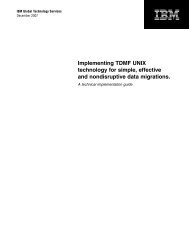Making Connections: Using SOA to enable collaboration in travel - IBM
Making Connections: Using SOA to enable collaboration in travel - IBM
Making Connections: Using SOA to enable collaboration in travel - IBM
Create successful ePaper yourself
Turn your PDF publications into a flip-book with our unique Google optimized e-Paper software.
<strong>SOA</strong> can be viewed<br />
as a complement <strong>to</strong><br />
exist<strong>in</strong>g systems,<br />
without fundamentally<br />
chang<strong>in</strong>g them.<br />
Countries can jo<strong>in</strong> the system over time, as<br />
agreements are established and resources<br />
become available. <strong>SOA</strong> technology standards<br />
can be complemented by exist<strong>in</strong>g (and future)<br />
<strong>in</strong>ternational trade standards. And system-<strong>to</strong>system<br />
communication can support <strong>in</strong>tegrated<br />
bus<strong>in</strong>ess processes, position<strong>in</strong>g the cus<strong>to</strong>ms<br />
organization for several strategic benefits.<br />
With systematic access <strong>to</strong> regulations, the<br />
large sophisticated trader can <strong>in</strong>tegrate these<br />
regulations directly <strong>in</strong><strong>to</strong> their documentation<br />
process from the start of the trade. This presents<br />
cus<strong>to</strong>ms with the opportunity <strong>to</strong> reduce<br />
<strong>in</strong>spection costs by p<strong>in</strong>po<strong>in</strong>t<strong>in</strong>g <strong>in</strong>spection on<br />
high-risk transactions, generate greater revenues<br />
and lower costs of collection.<br />
If cus<strong>to</strong>ms organizations were <strong>to</strong> build the<br />
<strong>SOA</strong> services for elective use, there is a<br />
strong case for trade participants <strong>to</strong> use the<br />
services. For consignees, the collaborative<br />
<strong>in</strong>tegration fostered by <strong>SOA</strong>-<strong>enable</strong>d logistics<br />
and cus<strong>to</strong>ms systems can provide potentially<br />
significant strategic, operations and f<strong>in</strong>ancial<br />
benefits. The strategic and operational benefits<br />
<strong>to</strong> this approach <strong>in</strong>clude:<br />
• The potential for reduced delay and<br />
disruption <strong>in</strong> trade execution. By hav<strong>in</strong>g<br />
realtime access <strong>to</strong> trade regulation <strong>in</strong>formation,<br />
compliance needs such as required<br />
documents or permits can be addressed<br />
when needed.<br />
• Reduced costs, through improved <strong>in</strong>ven<strong>to</strong>ry<br />
management, reduced losses and shorter<br />
cycle times all contribute <strong>to</strong> a lower cost of<br />
goods sold. The ability <strong>to</strong> collect <strong>in</strong>formation<br />
electronically contributes <strong>to</strong> lower compliance<br />
costs.<br />
14 <strong>IBM</strong> Global Bus<strong>in</strong>ess Services<br />
• Increased revenues, as goods that do not<br />
get held up for cus<strong>to</strong>ms <strong>in</strong>spections can get<br />
<strong>to</strong> market more quickly<br />
• Increased ability <strong>to</strong> anticipate and prevent<br />
disruption, as more <strong>in</strong>formation is available<br />
earlier <strong>in</strong> the process, <strong>in</strong> both realtime and<br />
electronically.<br />
• Improved sourc<strong>in</strong>g flexibility and better trade<br />
transaction management.<br />
The f<strong>in</strong>ancial benefits can vary by stakeholder,<br />
but overall, <strong>SOA</strong> can help create the environment<br />
<strong>in</strong> which trades can realize higher<br />
revenues and lower costs. In Figure 6, we<br />
show the different value propositions for each<br />
stakeholder group.<br />
Each stakeholder has the opportunity <strong>to</strong><br />
address a number of value levers through<br />
direct connectivity <strong>to</strong> cus<strong>to</strong>ms and <strong>in</strong>tegrated<br />
systems. For the large, sophisticated, system<strong>enable</strong>d<br />
trade participants, the ability <strong>to</strong> impact<br />
these metrics presents a compell<strong>in</strong>g argument<br />
<strong>to</strong> pursue the type of <strong>in</strong>tegration described <strong>in</strong><br />
this scenario.<br />
<strong>SOA</strong> can be viewed as a complement <strong>to</strong><br />
exist<strong>in</strong>g systems and does not fundamentally<br />
change those systems or mandate new<br />
systems. <strong>SOA</strong> offers a standards-based framework<br />
that can <strong>enable</strong> any participant <strong>in</strong> the<br />
process <strong>to</strong> connect <strong>to</strong> another without specific,<br />
po<strong>in</strong>t-<strong>to</strong>-po<strong>in</strong>t cus<strong>to</strong>m solutions. By <strong>in</strong>creas<strong>in</strong>g<br />
communication, connectivity and flexibility<br />
among exist<strong>in</strong>g systems, it liberates their<br />
potential <strong>to</strong> expedite, not retard, the system of<br />
global trade.

















